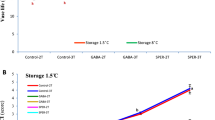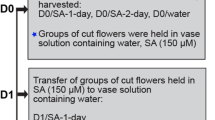Abstract
In this study, we were investigated the effect of lysosomal extracts (named as lysosomal enzymes) on extending the vase life of cut flowers. The results confirmed that senescence of cut freesia treated with lysosomal enzymes delayed. Also, the results for cut roses and lilies showed a similar pattern. In the case of them the fresh weight was lower than that of the control group, but time the ornamental value was retained increased by about 2 days. The reasons have explained as results by the change including stomata, accumulation of microbial population, and soluble carbohydrate contents. In conclusion, pretreatment with lysosomal enzymes has enhanced vase life and ornamental value of cut flowers. It has an important significance in improving the marketability of cut flowers in the flower industry. Therefore, lysosomal enzymes have the potential to be used sufficiently as eco-friendly and effective materials for pretreatment agents in the cut flower industry.







Similar content being viewed by others
Data Availability
Data sharing not applicable to this article as no datasets were generated or analyzed during the current study.
Change history
09 July 2022
A Correction to this paper has been published: https://doi.org/10.1007/s12033-022-00521-0
References
Fridman, A., & Friedman, G. (2012). Introduction to fundamental and applied aspects of plasma medicine. Plasma medicine. London: Wiley.
Huotari, J., & Helenius, A. (2011). Endosome maturation. The EMBO Journal, 30(17), 3481–3500. https://doi.org/10.1038/emboj.2011.286
Kolter, T., & Sandhoff, K. (2005). Principles of lysosomal membrane digestion: Stimulation of sphingolipid degradation by sphingolipid activator proteins and anionic lysosomal lipids. Annual Review of Cell and Developmental Biology, 21, 81–103. https://doi.org/10.1146/annurev.cellbio.21.122303.120013
Xu, H., & Ren, D. (2015). Lysosomal physiology. Annual Review of Physiology, 77, 57–80. https://doi.org/10.1146/annurev-physiol-021014-071649
Güçbilmez, Ç. M., Yemenicioğlu, A., & Arslanoğlu, A. (2007). Antimicrobial and antioxidant activity of edible zein films incorporated with lysozyme, albumin proteins and disodium EDTA. Food Research International, 40(1), 80–91. https://doi.org/10.1016/j.foodres.2006.08.007
Ibrahim, H. R., Inazaki, D., Abdou, A., Aoki, T., & Kim, M. (2005). Processing of lysozyme at distinct loops by pepsin: A novel action for generating multiple antimicrobial peptide motifs in the newborn stomach. Biochimica et Biophysica Acta (BBA)-General Subjects, 1726(1), 102–114. https://doi.org/10.1016/j.bbagen.2005.07.008
Reid, M. S. (1988). The role of ethylene in flower senescence. In: IV International Symposium on Postharvest Physiology of Ornamental Plants 261: 157–170. https://doi.org/10.1760/ActaHortic.1989.261.20
Zencirkiran, M. (2002). Cold storage of Freesia refracta ‘Cordula.’ New Zealand Journal of Crop and Horticultural Science, 30(3), 171–174. https://doi.org/10.1080/01140671.2002.9514212
Zencirkiran, M. (2010). Effects of 1MCP (1methylcyclopropene) and STS (silver thiosulphate) on the vase life of cut Freesia flowers. Scientific Research and Essays, 5(17), 2409–2412. https://doi.org/10.5897/SRE.9000419
Elgar, H. J., Woolf, A. B., & Bieleski, R. L. (1999). Ethylene production by three lily species and their response to ethylene exposure. Postharvest Biology and Technology, 16(3), 257–267. https://doi.org/10.1016/S0925-5214(99)00021-6
van Doorn, W. G., & Han, S. S. (2011). Postharvest quality of cut lily flowers. Postharvest Biology and Technology, 62(1), 1–6. https://doi.org/10.1016/j.postharvbio.2011.04.013
Kazemi, M., & Ameri, A. (2012). Effect of Ni, CO, SA and sucrose on extending the vase-life of lily cut flower. Iranica Journal of Energy & Environment, 3(2), 162–166. https://doi.org/10.5829/idosi.ijee.2012.03.02.0258
Raskin, I. (1992). Role of salicylic acid in plants. Annual Review of Plant Biology, 43(1), 439–463. https://doi.org/10.1146/annurev.pp.43.060192.002255
Hassan, F. A. S., & Ali, E. F. (2014). Protective effects of 1-methylcyclopropene and salicylic acid on senescence regulation of gladiolus cut spikes. Scientia Horticulturae, 179, 146–152. https://doi.org/10.1016/j.scienta.2014.09.025
Ichimura, K., Kojima, K., & Goto, R. (1999). Effects of temperature, 8-hydroxyquinoline sulphate and sucrose on the vase life of cut rose flowers. Postharvest Biology and Technology, 15(1), 33–40. https://doi.org/10.1016/S0925-5214(98)00063-5
Macnish, A. J., Leonard, R. T., Borda, A. M., & Nell, T. A. (2010). Genotypic variation in the postharvest performance and ethylene sensitivity of cut rose flowers. HortScience, 45(5), 790–796. https://doi.org/10.21273/HORTSCI.45.5.790
Van Doorn, W. G., De Witte, Y., & Perik, R. R. J. (1990). Effect of antimicrobial compounds on the number of bacteria in stems of cut rose flowers. Journal of Applied Bacteriology, 68(2), 117–122. https://doi.org/10.1111/j.1365-2672.1990.tb02555.x
Ghashghaie, J., Brenckmann, F., & Saugier, B. (1992). Water relations and growth of rose plants cultured in vitro under various relative humidities. Plant Cell, Tissue and Organ Culture, 30(1), 51–57. https://doi.org/10.1007/BF00040000
Gao, X. Q., Li, C. G., Wei, P. C., Zhang, X. Y., Chen, J., & Wang, X. C. (2005). The dynamic changes of tonoplasts in guard cells are important for stomatal movement in Vicia faba. Plant Physiology, 139(3), 1207–1216. https://doi.org/10.1104/pp.105.067520
Matile, P., & Winkenbach, F. (1971). Function of lysosomes and lysosomal enzymes in the senescing corolla of the morning glory (Ipomoea purpurea). Journal of Experimental Botany, 22(4), 759–771. https://doi.org/10.1093/jxb/22.4.759
Cho, M. C., Celikel, F., & Dodge, L. (1999). Sucrose enhances the postharvest quality of cut flowers of Eustoma grandiflorum (raf.) Shinn. In VII International Symposium on Postharvest Physiology of Ornamental Plants 543: 305–315. https://doi.org/10.17660/ActaHortic.2001.543.37
Kazemi, M., Hadavi, E., & Hekmati, J. (2011). Role of salicylic acid in decreases of membrane senescence in cut. American Journal of Plant Physiology, 6(2), 106–112. https://doi.org/10.3923/ajpp.2011.106.112
Kruger, N. J. (2009). The Bradford method for protein quantitation. The protein protocols handbook (pp. 17–24). Humana Press.
Choi, M. P., Joung, H. Y., Choi, Y. J., Goo, D. H., & Kang, Y. I. (2013). Vase life and quality as affected by storage conditions in cut freesia’Shiny Gold’. Korean Society for Floricultural Science, 21(1), 5–10. https://doi.org/10.1623/frj.2013.21.1.3
Ohkawa, K., Kasahara, Y., & Suh, J. N. (1999). Mobility and effects on vase life of silver-containing compounds in cut rose flowers. HortScience, 34(1), 112–113. https://doi.org/10.21273/HORTSCI.34.1.112
Kazemi, M., Hadavi, E., & Hekmati, J. (2010). The effect of malic acid on the bacteria populations of carnations vase solution. World Applied Sciences Journal, 10(7), 737–740.
Arrom, L., & Munné-Bosch, S. (2012). Sucrose accelerates flower opening and delays senescence through a hormonal effect in cut lily flowers. Plant Science, 188, 41–47. https://doi.org/10.1016/j.plantsci.2012.02.012
Gerailoo, S., & Ghasemnezhad, M. (2011). Effect of salicylic acid on antioxidant enzyme activity and petal senescence in ‘Yellow Island’cut rose flowers. Journal of Fruit and Ornamental Plant Research, 19(1), 183–193.
No Norikoshi, R., Shibata, T., Niki, T., & Ichimura, K. (2016). Sucrose treatment enlarges petal cell size and increases vacuolar sugar concentrations in cut rose flowers. Postharvest Biology and Technology, 116, 59–65. https://doi.org/10.1016/j.postharvbio.2016.01.003
Acknowledgements
This research was supported by Basic Science Research Program through the National Research Foundation of Korea (NRF) funded by the Ministry of Education (2021R1A2C2093580).
Author information
Authors and Affiliations
Contributions
M-YH and WC performed all of the experiments. B-NK and JL wrote the main manuscript text. Y-HK and JM designed the overall experimental concept, and revised the manuscript.
Corresponding authors
Ethics declarations
Conflict of interest
The authors declare that they have no conflict of interest.
Informed Consent
Informed consent was obtained from all individual participants included in the study
Research Involving Human Participants and/or Animals
This article does not contain any studies with human participants or animals performed by any of the authors.
Additional information
Publisher's Note
Springer Nature remains neutral with regard to jurisdictional claims in published maps and institutional affiliations.
Rights and permissions
About this article
Cite this article
Heo, MY., Kim, BN., Lee, J. et al. Effect of Lysosomes on Extending Vase Life of Cut Flowers. Mol Biotechnol 64, 1340–1349 (2022). https://doi.org/10.1007/s12033-022-00509-w
Received:
Accepted:
Published:
Issue Date:
DOI: https://doi.org/10.1007/s12033-022-00509-w




